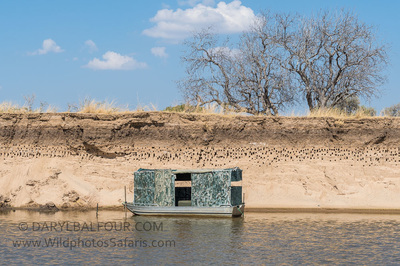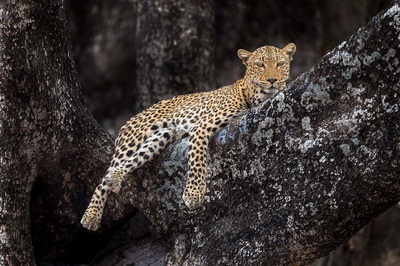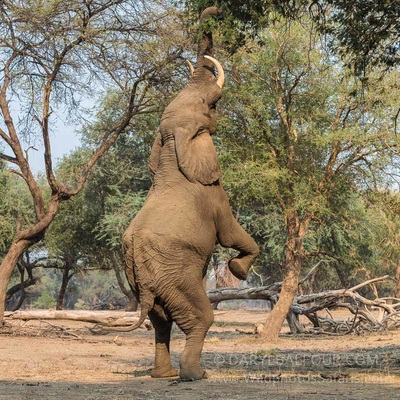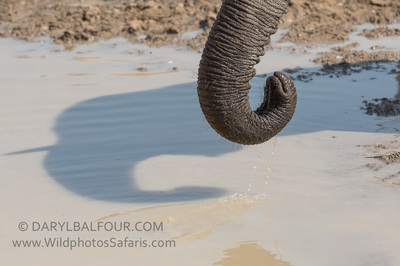Carmine Bee-Eaters, Dancing Elephants...& a few leopards too!
ZAMBIA – SOUTH LUANGWA NATIONAL PARK & LOWER ZAMBEZI VALLEY
Enquire Now for our 2022 Departure
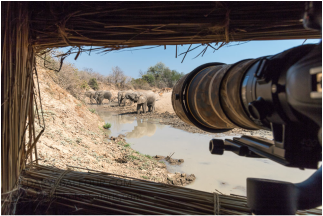
Photographing from Mwamba's unique Last Waterhole photo blind
In the heart of the African subcontinent lies a destination known as “real Africa”. This is Zambia, where you will find remote wilderness areas, breathtaking scenery, wildlife in abundance and a kindhearted people. Of all Zambia’s parks, South Luangwa & the Lower Zambezi have perhaps achieved the most acclaim and these are parks that regularly attract and feature on television channels such as National Geographic, Discovery, Animal Planet and BBC Wildlife.
We have negotiated a special photographic departure for Daryl Balfour WILDPHOTOS SAFARIS guests with only four passengers plus myself in a vehicle and the use of up to six different photographic blinds and hides (left) located at strategic viewing & photographic locations in the South Luangwa reserve.
“One of the wonderful features of these camps is the network of blinds set up each year to allow close-up views of hippos, elephants, and the other wildlife. From the hippo hide, hidden in a corner of the Luangwa River you are close enough to feel as if you are part of the pod – a truly unique perspective that is both a tribute to Derek Shenton’s ingenuity and to his superb knowledge of the Luangwa Valley.” Frans Lanting – National Geographic
However, these hides are not just for photographers and film makers. They are for anyone who loves wildlife. They provide a unique up-close-and-personal view into the lives of these animals, enabling you to watch them undisturbed in their natural environment. That said, we are well equipped to take care of photographers, and we provide specialist bean bags, dust covers and battery charging facilities.
We offer a variety of activities ranging from game drives, walking safaris, night drives to photographic hide trips. We are focused on the wildlife experience, and we will be able to undertake three rather than the standard two activities per day for those with enough energy!
Our camps are located deep within the richest game viewing area of the South Luangwa National Park. The areas surrounding the camps are incredibly rich in wildlife, and the vast volume of prey species such as:Leopards – for which South Luangwa is famous, Lions, Wild dogs, Hippo’s – a specialty of the Luangwa River, Elephants, Buffalo, Puku, Impala, Zebra, Greater Kudu, Giraffe and Waterbuckattracts many predators. As many as 11 different leopards have been identified around our camps. As unpredictable as these wild leopards can be, an incredible 95% of guests get to see these stunning cats. There are also two very strong Lion Prides in the area, which are named the Mwamba Pride and the Hollywood pride, the latter getting their name due to the vast amount of time documentary filmmakers have spent following them. Birdlife in the area can also be spectacular.
We have negotiated a special photographic departure for Daryl Balfour WILDPHOTOS SAFARIS guests with only four passengers plus myself in a vehicle and the use of up to six different photographic blinds and hides (left) located at strategic viewing & photographic locations in the South Luangwa reserve.
“One of the wonderful features of these camps is the network of blinds set up each year to allow close-up views of hippos, elephants, and the other wildlife. From the hippo hide, hidden in a corner of the Luangwa River you are close enough to feel as if you are part of the pod – a truly unique perspective that is both a tribute to Derek Shenton’s ingenuity and to his superb knowledge of the Luangwa Valley.” Frans Lanting – National Geographic
However, these hides are not just for photographers and film makers. They are for anyone who loves wildlife. They provide a unique up-close-and-personal view into the lives of these animals, enabling you to watch them undisturbed in their natural environment. That said, we are well equipped to take care of photographers, and we provide specialist bean bags, dust covers and battery charging facilities.
We offer a variety of activities ranging from game drives, walking safaris, night drives to photographic hide trips. We are focused on the wildlife experience, and we will be able to undertake three rather than the standard two activities per day for those with enough energy!
Our camps are located deep within the richest game viewing area of the South Luangwa National Park. The areas surrounding the camps are incredibly rich in wildlife, and the vast volume of prey species such as:Leopards – for which South Luangwa is famous, Lions, Wild dogs, Hippo’s – a specialty of the Luangwa River, Elephants, Buffalo, Puku, Impala, Zebra, Greater Kudu, Giraffe and Waterbuckattracts many predators. As many as 11 different leopards have been identified around our camps. As unpredictable as these wild leopards can be, an incredible 95% of guests get to see these stunning cats. There are also two very strong Lion Prides in the area, which are named the Mwamba Pride and the Hollywood pride, the latter getting their name due to the vast amount of time documentary filmmakers have spent following them. Birdlife in the area can also be spectacular.
South Luangwa NP
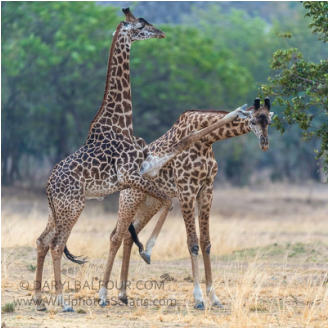
Two male Thornicroft's giraffes in a sparring match at Kaingo Camp.
Bush Camps
The two camps we use in South Luangwa are situated on either side of ‘Lion Plain’, and the surrounding terrain varies from ancient ebony groves to large lagoon networks.
Kaingo Camp is located on a beautiful stretch of the Luangwa River. It has only six chalets, each one equipped with an indoor en suite bathroom as well as a bathtub outdoors nestled on the riverbank. Each chalet has an individual deck over the river from which to watch game coming to drink. Kaingo’s famous bar is made of an ancient fallen leadwood tree which is over 1200 years of age.
Mwamba Bush Camp is an intimate ‘reed and thatch’ chalet camp catering to only six guests & is thus used only on our June/July safari. Each chalet has soaring skylights and en suite bathrooms open to the stars. This camp is situated on the banks of the Mwamba River in the grasslands next to ‘Lion Plain’. The Mwamba pride of lions frequent the camp as they follow the buffalo herds in their journey to and from the Luangwa River. Our camps are extremely eco-friendly, and run on solar power. Mwamba’s Last Waterhole Hide is perched on an outcrop directly above an active waterhole (right). This waterhole is busy throughout the season, but is most spectacular from late September when all the other water in the area has dried up. This waterhole provides fantastic opportunities to watch thirsty species of game coming to drink. The stage remains constant but the players change throughout the day – it is very easy to while away hours in this hide watching the ever changing show. It is particularly good in the mornings between 8 and 9am.
The two camps we use in South Luangwa are situated on either side of ‘Lion Plain’, and the surrounding terrain varies from ancient ebony groves to large lagoon networks.
Kaingo Camp is located on a beautiful stretch of the Luangwa River. It has only six chalets, each one equipped with an indoor en suite bathroom as well as a bathtub outdoors nestled on the riverbank. Each chalet has an individual deck over the river from which to watch game coming to drink. Kaingo’s famous bar is made of an ancient fallen leadwood tree which is over 1200 years of age.
Mwamba Bush Camp is an intimate ‘reed and thatch’ chalet camp catering to only six guests & is thus used only on our June/July safari. Each chalet has soaring skylights and en suite bathrooms open to the stars. This camp is situated on the banks of the Mwamba River in the grasslands next to ‘Lion Plain’. The Mwamba pride of lions frequent the camp as they follow the buffalo herds in their journey to and from the Luangwa River. Our camps are extremely eco-friendly, and run on solar power. Mwamba’s Last Waterhole Hide is perched on an outcrop directly above an active waterhole (right). This waterhole is busy throughout the season, but is most spectacular from late September when all the other water in the area has dried up. This waterhole provides fantastic opportunities to watch thirsty species of game coming to drink. The stage remains constant but the players change throughout the day – it is very easy to while away hours in this hide watching the ever changing show. It is particularly good in the mornings between 8 and 9am.
Lower Zambezi NP
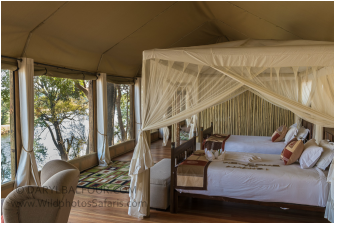
Plush interior of a luxurious Amanzi tent.
From South Luangwa, where we will spend four nights in both Kaingo and Mwamba Camps, we fly to the Lower Zambezi National Park on the banks of the mighty Zambezi River. Here we will spend three nights at Amanzi Camp situated on the banks of the Zambezi. Our activities here will include exploring the wilderness by 4x4 vehicles as well as by boats or canoes on the Zambezi River. The Lower Zambezi area is one of the most scenically spectacular wildlife viewing areas in Africa, and the great Zambezi River truly a lifetime experience. Great photographic opportunities await you here, either on the river by boat or in the valley & its floodplains by 4x4 or on foot.
Safari dates
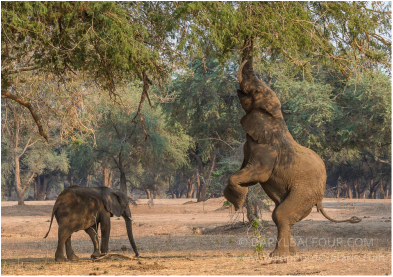
Bull elephants here will stand on their hind legs to reach succulent seed-pods
The best time to visit Zambia is between the 20th of May when the camps open and the 31st of October when they close for the rainy season. The season is very short, and the game viewing is exceptional throughout. The weather is temperate during the early part of the season, cooler in July, and hot to very hot in September and October. September however offers the best game viewing, and it is the peak of the carmine-bee-eater nesting season.
We have opted to run only one departure in 2022 - please ask us HERE about dates. Our set departure runs from Lusaka, and ending back in Lusaka seven days later.
Enquire about specific dates and prices now, or let us tailor-make an itinerary just for you if you would prefer other dates during the season!
We have opted to run only one departure in 2022 - please ask us HERE about dates. Our set departure runs from Lusaka, and ending back in Lusaka seven days later.
Enquire about specific dates and prices now, or let us tailor-make an itinerary just for you if you would prefer other dates during the season!
Contact us HERE now for a PDF brochure with more details of this safari
Click on the images below for captions & location details.




